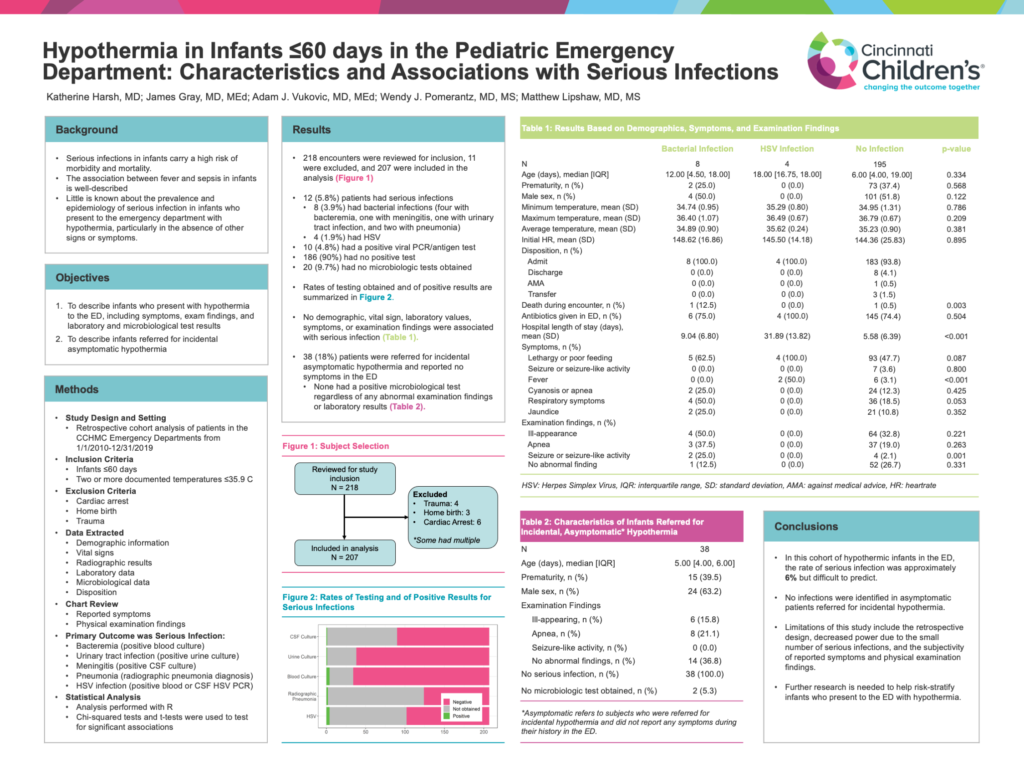Hypothermia in Infants ≤60 days in the Pediatric Emergency Department: Characteristics and Associations with Serious Infections
Katherine Harsh, MD; James Gray, MD, MEd; Adam J. Vukovic, MD, MEd; Wendy J. Pomerantz, MD, MS; Matthew Lipshaw, MD, MS

Although hypothermia is commonly considered a sign of sepsis in infants, the true prevalence of infection in infants presenting to the ED with hypothermia is overall poorly understood. Our study did not find any significant associations with the presence of serious infection, but further research is needed to better characterize this population and potentially identify a low-risk cohort of infants.
Katherine Harsh, MD
Abstract
Background: Serious infections in infants carry a high risk of morbidity and mortality. The association between fever and sepsis in infants is well-described, but little is known about the prevalence and epidemiology of serious infection in infants who present with hypothermia, particularly in the absence of other signs or symptoms.
Objectives: We aimed to describe infants who present with hypothermia to the emergency department (ED), including symptoms, exam findings, and laboratory and microbiological test results, and to describe infants referred for incidental asymptomatic hypothermia.
Methods: We performed a retrospective analysis of all infants ≤60 days with two or more documented temperatures ≤35.9°C in our ED between 2010 and 2019. Patients presenting due to cardiac arrest, home births, and trauma were excluded. From the medical record, we extracted demographic, vital sign, radiographic, laboratory, and microbiological data (blood, urine, CSF, and respiratory). We manually reviewed charts for reported symptoms and documented examination findings. Statistical analysis was performed to evaluate for associations with serious infection. Serious infection was defined as bacterial infection (positive blood, urine, or CSF culture or radiographic pneumonia) or HSV infection (positive blood or CSF HSV PCR).
Results: 207 patient encounters met inclusion criteria. Twelve patients (5.8%) had serious infections. Of these, eight (3.9%) patients had bacterial infections (four with bacteremia, one with meningitis, one with urinary tract infection, and two with pneumonia) and four (1.9%) had HSV. Ten (4.8%) patients had a positive viral PCR/antigen test. The remaining 186 (90%) patients had no positive test; twenty (9.7%) patients had no microbiologic tests obtained. No demographic, vital sign, laboratory values, symptoms, or examination findings were associated with serious infection. Thirty-eight (18%) patients were referred for incidental asymptomatic hypothermia; none of these had a positive microbiological test, regardless of any abnormal examination findings or laboratory results.
Conclusions: In this cohort of hypothermic infants in the ED, the rate of serious infection was approximately 6%, but difficult to predict. No infections were identified in asymptomatic patients referred for incidental hypothermia. Further research is needed to help risk-stratify infants who present to the ED with hypothermia.
Table 1. Patient Demographics, Symptoms, and Examination Findings by Infection Status
| Bacterial Infection | HSV Infection | No Infection | |
| N | 8 | 4 | 195 |
| Age (days), median [IQR] | 12.00 [4.50, 18.00] | 18.00 [16.75, 18.00] | 6.00 [4.00, 19.00] |
| Prematurity, n (%) | 2 (25.0) | 0 (0.0) | 73 (37.4) |
| Male sex, n (%) | 4 (50.0) | 0 (0.0) | 101 (51.8) |
| Ethnicity, n (%) | |||
| Hispanic | 0 (0.0) | 0 (0.0) | 9 (4.6) |
| Non-Hispanic | 8 (100.0) | 4 (100.0) | 184 (94.4) |
| Unknown | 0 (0.0) | 0 (0.0) | 2 (1.0) |
| Race, n (%) | |||
| Asian | 0 (0.0) | 0 (0.0) | 7 (3.6) |
| Black or African American | 2 (25.0) | 2 (50.0) | 49 (25.1) |
| Hispanic/Latino | 0 (0.0) | 0 (0.0) | 3 (1.5) |
| White | 6 (75.0) | 2 (50.0) | 118 (60.5) |
| Multiple | 0 (0.0) | 0 (0.0) | 10 (5.1) |
| Preferred Category Not Available | 0 (0.0) | 0 (0.0) | 2 (1.0) |
| Unknown | 0 (0.0) | 0 (0.0) | 6 (3.1) |
| Minimum temperature, mean (SD) | 34.74 (0.95) | 35.29 (0.80) | 34.95 (1.31) |
| Maximum temperature, mean (SD) | 36.40 (1.07) | 36.49 (0.67) | 36.79 (0.67) |
| Average temperature, mean (SD) | 34.89 (0.90) | 35.62 (0.24) | 35.23 (0.90) |
| Initial HR, mean (SD) | 148.62 (16.86) | 145.50 (14.18) | 144.36 (25.83) |
| Disposition, n (%) | |||
| Admit | 8 (100.0) | 4 (100.0) | 183 (93.8) |
| Discharge | 0 (0.0) | 0 (0.0) | 8 (4.1) |
| AMA | 0 (0.0) | 0 (0.0) | 1 (0.5) |
| Transfer | 0 (0.0) | 0 (0.0) | 3 (1.5) |
| Death during encounter, n (%) | 1 (12.5) | 0 (0.0) | 1 (0.5) |
| Antibiotics given in ED, n (%) | 6 (75.0) | 4 (100.0) | 145 (74.4) |
| Hospital length of stay (days), mean (SD) | 9.04 (6.80) | 31.89 (13.82) | 5.58 (6.39) |
| Symptoms, n (%) | |||
| Lethargy or poor feeding | 5 (62.5) | 4 (100.0) | 93 (47.7) |
| Seizure or seizure-like activity | 0 (0.0) | 0 (0.0) | 7 (3.6) |
| Fever | 0 (0.0) | 2 (50.0) | 6 (3.1) |
| Cyanosis or apnea | 2 (25.0) | 0 (0.0) | 24 (12.3) |
| Respiratory symptoms | 4 (50.0) | 0 (0.0) | 36 (18.5) |
| Jaundice | 2 (25.0) | 0 (0.0) | 21 (10.8) |
| Examination findings, n (%) | |||
| Ill-appearance | 4 (50.0) | 0 (0.0) | 64 (32.8) |
| Apnea | 3 (37.5) | 0 (0.0) | 37 (19.0) |
| Seizure or seizure-like activity | 2 (25.0) | 0 (0.0) | 4 (2.1) |
| No abnormal finding | 1 (12.5) | 0 (0.0) | 52 (26.7) |
| HSV: Herpes Simplex Virus, IQR: interquartile range, SD: standard deviation, AMA: against medical advice |